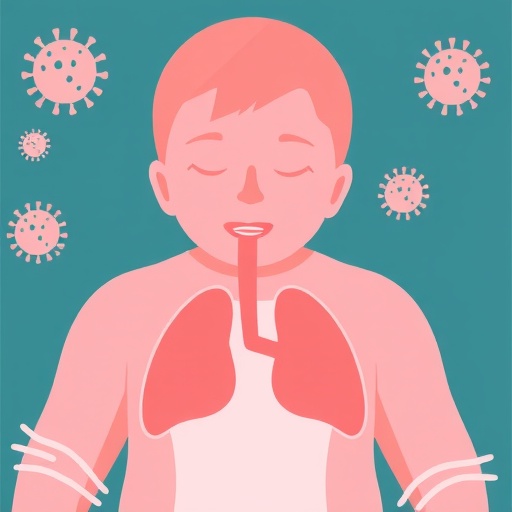In the ever-evolving landscape of infectious disease research, understanding the precise factors that contribute to the risk and severity of respiratory syncytial virus (RSV) infection remains a monumental challenge. A landmark prospective cohort study recently published in Nature Communications offers groundbreaking insights into the correlates of risk associated with RSV, shedding light on the complex interplay between host immune responses and viral pathogenesis. This extensive investigation, spearheaded by Frivold, Cox, Starita, and colleagues, stakes new ground in the quest to delineate predictive markers and protective immune correlates that could revolutionize prevention and treatment strategies for this pervasive respiratory illness.
RSV continues to exert a significant global health burden, particularly among infants, young children, and older adults, where it regularly precipitates severe respiratory disease. Despite decades of study, comprehensive risk stratification has remained elusive. This study ventures into uncharted territory by leveraging a prospective cohort design, meticulously following participants over time to capture dynamic immune profiles prior to and during RSV infection. The analysis crosses traditional boundaries, integrating sophisticated immunological assays, viral load measurements, and clinical metadata to construct a multidimensional portrait of disease susceptibility.
At the heart of the study’s approach is the identification of immune correlates that forecast RSV disease risk. Unlike retrospective designs that often rely on post-infection snapshots, this longitudinal framework enables the detection of pre-infection immune states that predicate disease susceptibility or resilience. The investigators collected peripheral blood samples at baseline and throughout infection, utilizing advanced flow cytometry and serological testing to quantify a broad spectrum of immune effectors. These included neutralizing antibody titers, T cell subsets, cytokine profiles, and markers of innate immune activation, all of which were then correlated with clinical outcomes.
A striking revelation from the data is the heterogeneity in baseline antibody-mediated immunity and its differential impact on disease trajectory. Subjects exhibiting higher titers of RSV-specific neutralizing antibodies before exposure were markedly less likely to develop severe lower respiratory tract involvement. This highlights the protective role of humoral immunity and emphasizes the potential of vaccines engineered to elicit robust neutralizing responses. Intriguingly, the quality rather than just the quantity of these antibodies—such as their affinity and epitope specificity—emerged as a crucial parameter influencing clinical outcomes.
Beyond antibodies, the study provides compelling evidence that cellular immune responses shape RSV disease risk in nuanced ways. Elevated frequencies of memory CD8+ T cells with potent cytotoxic capabilities prior to infection were associated with diminished viral load and alleviated symptom severity. Conversely, dysregulated activation of certain CD4+ T cell subsets, particularly those skewed towards pro-inflammatory cytokine secretion, correlated with heightened risk of severe pathology. This dualistic role underscores the delicate balance between protective immunity and immunopathology in RSV pathogenesis.
The innate immune arm also figures prominently in the risk landscape detailed by the researchers. Elevated baseline expression of pattern recognition receptors and enhanced type I interferon signaling pathways were indicative of a primed antiviral state, which translated into more effective early viral control. However, excessive or prolonged innate activation appeared paradoxically linked to tissue damage and exacerbated respiratory symptoms. These findings reinforce the concept that temporally tuned innate responses are central to navigating the fine line between protection and pathology in RSV infection.
Importantly, the study’s cohort encompassed a diverse population in terms of age, genetic background, and environmental exposures, adding robustness and generalizability to the findings. Subgroup analyses revealed that age-related differences in immune correlates had significant implications for susceptibility. For example, infants with immature adaptive immunity displayed a heavier reliance on innate defenses, which were often insufficient to prevent severe disease, whereas older adults demonstrated waning humoral memory responses that predisposed them to similar vulnerabilities. These age-dependent immune landscapes highlight the need for tailored preventive interventions.
The multi-omic nature of the investigation further illuminated the molecular underpinnings of RSV susceptibility. Integration of transcriptomic data with immunophenotyping revealed distinct gene expression signatures predictive of severe outcomes. Key pathways implicated included those governing cellular metabolism, apoptosis regulation, and inflammatory cascades. These signatures hold promise for the future development of diagnostic tools capable of stratifying patients at risk for aggressive disease, potentially guiding early therapeutic interventions.
Another pivotal component of this research was the examination of viral factors contributing to disease severity. Through longitudinal sampling, the authors characterized viral load dynamics and strain variation within the cohort. They observed that higher viral replication rates correlated with increased immune activation and worse clinical scores, suggesting that viral burden remains a critical driver of pathogenicity. Furthermore, certain viral genetic variants appeared to modulate immune evasion capabilities, subtly influencing host-pathogen interplay and clinical outcomes.
The translational implications of these findings are profound. By elucidating immune correlates predictive of RSV risk, the study lays a scientific foundation for the rational design of next-generation vaccines and immunotherapies. Vaccines that elicit both potent neutralizing antibody responses and balanced T cell immunity, with careful modulation of innate activation, could offer superior protection. Additionally, the identification of gene expression biomarkers may enable personalized medicine approaches, whereby at-risk individuals receive intensified prophylaxis or early antiviral treatment to mitigate disease progression.
Moreover, this comprehensive investigation challenges previously held notions that singular immune components dictate RSV outcomes. Instead, it underscores the necessity of a systems immunology perspective that appreciates the orchestrated interactions between humoral, cellular, and innate immunity. This paradigm shift encourages multidisciplinary collaborations to fully unravel the intricacies of RSV pathogenesis and opens avenues for integrative therapeutic development.
Despite its groundbreaking contributions, the study acknowledges limitations inherent in observational cohort designs, such as potential confounding factors and the challenge of fully capturing mucosal immune responses, which are critically involved in respiratory infections. Future research directions entail deeper exploration of tissue-resident immunity and the role of the respiratory microbiome in modulating RSV risk. Additionally, expanding the cohort size and diversity will further refine our understanding of immune correlates across populations.
The publication of this prospective study in Nature Communications marks a pivotal advance in infectious disease research. Its meticulous methodology, comprehensive immunological profiling, and nuanced analysis offer a blueprint for tackling other complex viral diseases. As global health systems brace for seasonal RSV surges and potential pandemics, these insights provide a beacon guiding vaccine strategies and personalized medicine initiatives designed to reduce the global burden of RSV-associated respiratory illness.
In sum, Frivold and colleagues’ landmark study transcends conventional research boundaries by integrating cutting-edge immunology, virology, and bioinformatics to elucidate the multifaceted correlates of RSV disease risk. The data reveals that protection and susceptibility arise from a sophisticated interplay of humoral and cellular immune factors, influenced by age, viral characteristics, and molecular pathways. This comprehensive risk profiling not only enhances our biological understanding of RSV but also propels the field towards innovative interventions that could dramatically improve public health outcomes worldwide.
Subject of Research: Respiratory Syncytial Virus (RSV) disease risk correlates and immune response dynamics.
Article Title: Correlates of risk of respiratory syncytial virus disease: a prospective cohort study.
Article References:
Frivold, C., Cox, S.N., Starita, L. et al. Correlates of risk of respiratory syncytial virus disease: a prospective cohort study.
Nat Commun 16, 8490 (2025). https://doi.org/10.1038/s41467-025-63434-x
Image Credits: AI Generated
Tags: clinical metadata in infectious disease studiesdynamic immune profiles in RSVglobal health burden of RSVimmune responses to RSV infectionimmunological assays for RSV researchprevention strategies for respiratory syncytial virus.prospective cohort study on RSVprotective immune correlates for RSVrespiratory syncytial virus risk factorsrisk stratification for RSV diseasesevere respiratory illness in infantsviral pathogenesis in respiratory diseases





